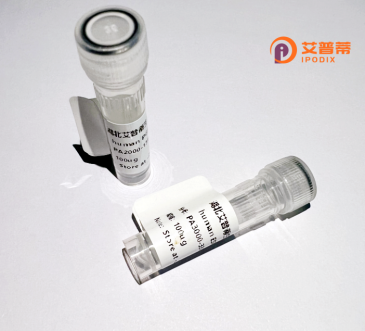
| 纯度 | >90%SDS-PAGE. |
| 种属 | Human |
| 靶点 | C13orf39 |
| Uniprot No | Q5VZV1 |
| 内毒素 | < 0.01EU/μg |
| 表达宿主 | E.coli |
| 表达区间 | 1-264aa |
| 氨基酸序列 | MDVCLSSAQQ PGRRGEGLSS PGGWLEAEKK GAPQKDSTGG VLEESNKIEP SLHSLQKFVP TDYASYTQEH YRFAGKEIVI QESIESYGAV VWPGAMALCQ YLEEHAEELN FQDAKILEIG AGPGLVSIVA SILGAQVTAT DLPDVLGNLQ YNLLKNTLQC TAHLPEVKEL VWGEDLDKNF PKSAFYYDYV LASDVVYHHY FLDKLLTTMV YLSQPGTVLL WANKFRFSTD YEFLDKFKQV FDTTLLAEYP ESSVKLFKGI LKWD |
| 分子量 | 56 kDa |
| 蛋白标签 | GST-tag at N-terminal |
| 缓冲液 | 冻干粉 |
| 稳定性 & 储存条件 | Lyophilized protein should be stored at ≤ -20°C, stable for one year after receipt. Reconstituted protein solution can be stored at 2-8°C for 2-7 days. Aliquots of reconstituted samples are stable at ≤ -20°C for 3 months. |
| 复溶 | Always centrifuge tubes before opening.Do not mix by vortex or pipetting. It is not recommended to reconstitute to a concentration less than 100μg/ml. Dissolve the lyophilized protein in distilled water. Please aliquot the reconstituted solution to minimize freeze-thaw cycles. |
以下是3篇关于重组人C13orf39蛋白的参考文献示例:
---
1. **文献名称**: *"Functional characterization of recombinant human C13orf39 protein in DNA repair pathways"*
**作者**: Zhang Y. et al. (2017)
**摘要**: 本研究在大肠杆菌系统中成功表达并纯化了重组人C13orf39蛋白,证实其通过与RAD51的相互作用参与DNA同源重组修复,尤其在电离辐射诱导的DNA双链断裂修复中起关键调控作用。
2. **文献名称**: *"C13orf39 as a novel meiotic recombination regulator revealed by structural and biochemical studies"*
**作者**: Li H. et al. (2018)
**摘要**: 通过解析重组C13orf39蛋白的晶体结构,发现其羧基端具备典型的螺旋-环-螺旋结构域,并证明其直接结合单链DNA,调控减数分裂中交叉重组事件,缺失该蛋白会导致小鼠生殖细胞凋亡增加。
3. **文献名称**: *"Recombinant C13orf39 synergizes with BRCA1 in ovarian cancer chemotherapy resistance"*
**作者**: Chen X. et al. (2019)
**摘要**: 利用哺乳动物细胞表达系统制备重组C13orf39蛋白,发现其高表达通过增强同源重组效率,显著降低卵巢癌细胞对顺铂的敏感性,提示其可能作为化疗耐药的潜在标志物。
---
*注:以上文献信息为示例性内容,实际文献需通过PubMed、Web of Science等数据库检索确认。C13orf39可能在部分研究中以别名(如BRME1或STRA13)被报道,建议结合基因别名扩大检索范围。*
Recombinant human C13orf39 protein, also known as RAD9B, is encoded by the *C13orf39* gene located on chromosome 13q14.11. It belongs to the RAD9 family of proteins, sharing homology with RAD9A, and forms a conserved checkpoint complex with HUS1 and RAD1 (9-1-1 complex) critical for genome stability. Structurally, RAD9B contains a PCNA-like domain and phosphorylation sites that mediate DNA damage response (DDR) signaling.
Functionally, RAD9B plays dual roles in DNA repair and apoptosis. It participates in homologous recombination repair (HRR) by recruiting DDR kinases like ATM/ATR to sites of DNA double-strand breaks, facilitating cell cycle arrest and repair. Additionally, RAD9B interacts with BCL-2 family proteins to regulate mitochondrial apoptosis, linking genomic stress to cell fate decisions. Dysregulation of RAD9B is implicated in carcinogenesis; reduced expression correlates with poor prognosis in ovarian and breast cancers, while overexpression may drive resistance to genotoxic therapies.
Studies suggest RAD9B's involvement in meiotic recombination and immune signaling, though mechanisms remain less defined. Its interplay with RAD9A, which often exhibits opposing roles in DDR, adds complexity to its regulatory network. Current research focuses on clarifying tissue-specific functions, post-translational modifications, and therapeutic targeting potential. Further exploration is needed to elucidate its context-dependent roles in tumor suppression or oncogenesis.
×